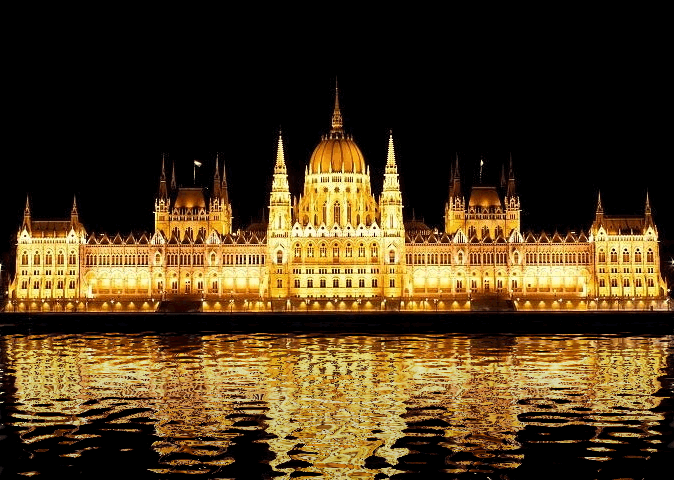 The M1 yellow subway line ended at Vörösmarty Square. Back in the city center, we bypassed our original plans to take a break at the hotel, as we still had plenty of sightseeing to do and so little time to do it in. In retrospect, we should have added a day to our Dubrovnik and Budapest visits. As it was, I had already missed out on one site on my list. Once an ardent philatelist, I wanted to see the Bélyegmúzeum, the stamp museum, as I own quite a nice collection of Hungarian stamps, but we had to forgo this attraction in favor of others.
The M1 yellow subway line ended at Vörösmarty Square. Back in the city center, we bypassed our original plans to take a break at the hotel, as we still had plenty of sightseeing to do and so little time to do it in. In retrospect, we should have added a day to our Dubrovnik and Budapest visits. As it was, I had already missed out on one site on my list. Once an ardent philatelist, I wanted to see the Bélyegmúzeum, the stamp museum, as I own quite a nice collection of Hungarian stamps, but we had to forgo this attraction in favor of others.
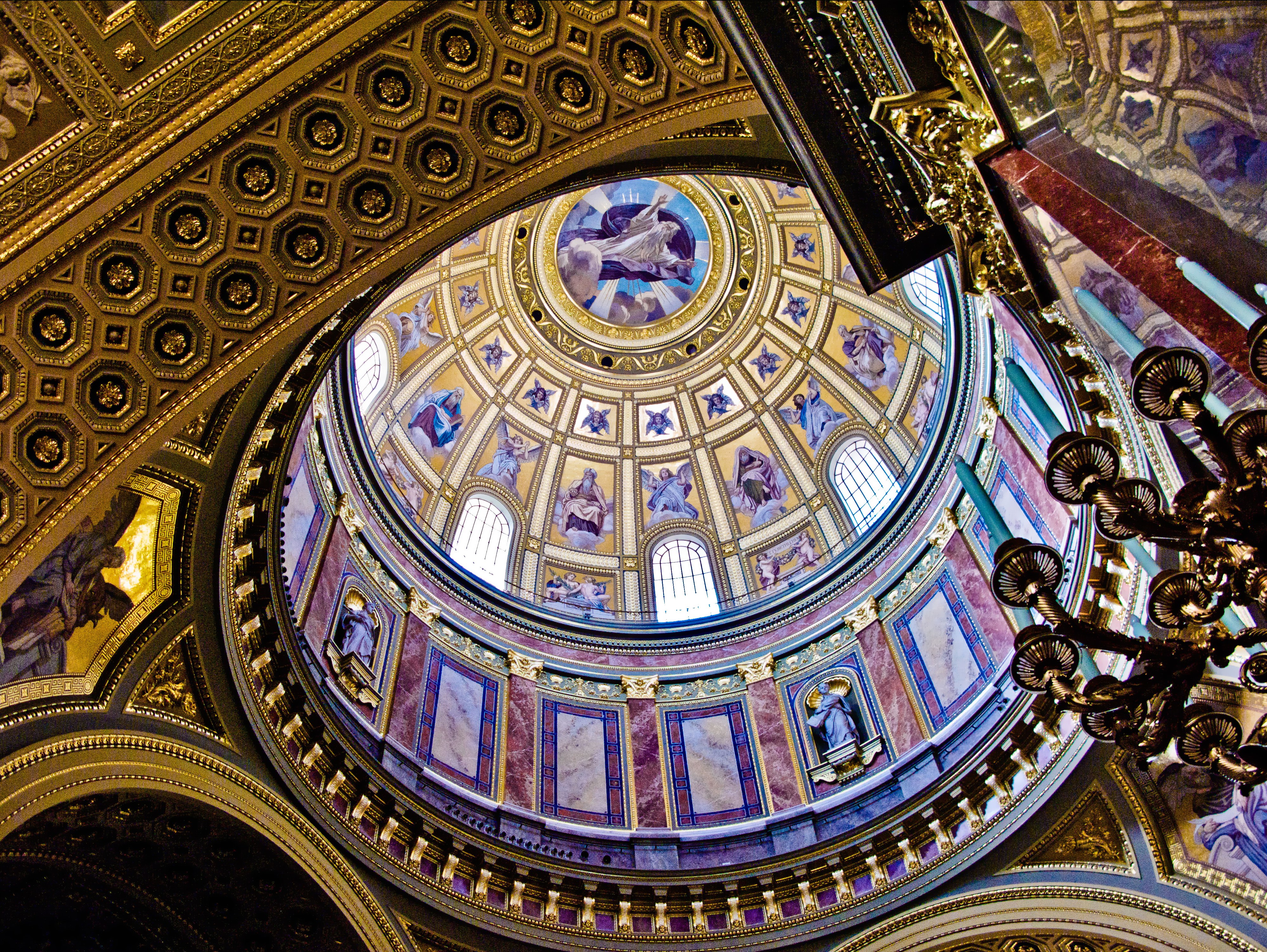 From the city center, we headed straight to St. Stephen’s Basilica, one of Budapest’s greatest landmarks on the Pest side of the city. Construction was completed in 1906, and due to its eclectic neoclassical style, the church took fifty years to build. The basilica is named after the first king of Hungary, King Stephen. The interior is exquisite, decorated with beautiful frescoes, statues, and mosaics, as well as 150 kinds of marble from around the country. The massive church can hold around 8,500 worshippers. In the chapel on the left is the mummified hand of St. Stephen. But what mesmerized me was the cupola, the colors striking—even more so when the sun shone through the glass, making its second appearance of the day (the first being when we passed the House of Terror.
From the city center, we headed straight to St. Stephen’s Basilica, one of Budapest’s greatest landmarks on the Pest side of the city. Construction was completed in 1906, and due to its eclectic neoclassical style, the church took fifty years to build. The basilica is named after the first king of Hungary, King Stephen. The interior is exquisite, decorated with beautiful frescoes, statues, and mosaics, as well as 150 kinds of marble from around the country. The massive church can hold around 8,500 worshippers. In the chapel on the left is the mummified hand of St. Stephen. But what mesmerized me was the cupola, the colors striking—even more so when the sun shone through the glass, making its second appearance of the day (the first being when we passed the House of Terror.
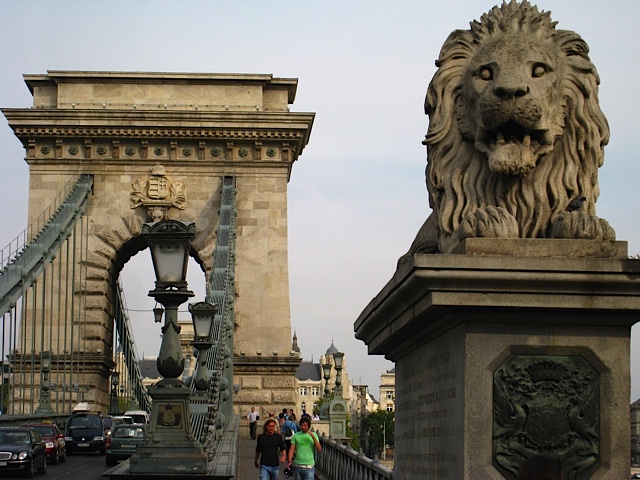 In mid-afternoon, we crossed the Chain Bridge, a nineteenth-century suspension bridge that spans the Danube River and links the Pest and Buda sides of the city. Wide, huge chains connected to the two towers gave rise to the name “Chain Bridge.” The towers are richly decorated with the Hungarian coat-of-arms and stone lions. As soon as we reached the other side of the bridge, we paused to photograph the tunnel, the entrance to the Castle District, but opted not to hike the steep hill. Instead, we rode the funicular railway to the top, slowly inching our way up the incline.
In mid-afternoon, we crossed the Chain Bridge, a nineteenth-century suspension bridge that spans the Danube River and links the Pest and Buda sides of the city. Wide, huge chains connected to the two towers gave rise to the name “Chain Bridge.” The towers are richly decorated with the Hungarian coat-of-arms and stone lions. As soon as we reached the other side of the bridge, we paused to photograph the tunnel, the entrance to the Castle District, but opted not to hike the steep hill. Instead, we rode the funicular railway to the top, slowly inching our way up the incline.
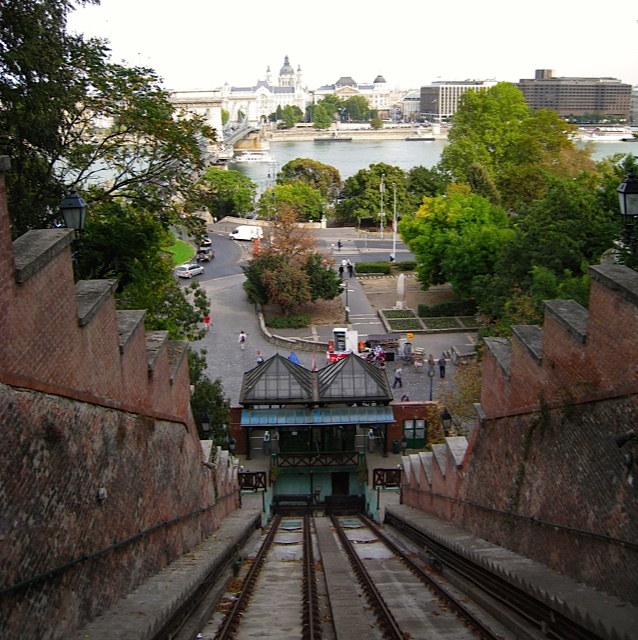 We exited the funicular, found our bearings, and began exploring Budapest’s Castle District. The hill has many interesting historic sights all in one location. We started with the palace, the first royal residence. It was built in the thirteenth century after the Mongolian invasion and added onto in the fourteenth century. At the time, it was the largest Gothic palace of the late Middle Ages. In the fifteenth century, construction on the palace continued, but with a Renaissance design. This structure was completely destroyed in 1686 during the liberation of Buda from the Turks. In the eighteenth century, a smaller baroque palace replaced the destroyed structure, and construction continued until the palace was completed in 1904. Heavily damaged by the end of World War II, the palace was rebuilt, this time in the neo-baroque style. All of this building and rebuilding was, for me, a true testament to man’s perseverance. Today, the Royal Palace is home to the Hungarian National Gallery and the Budapest History Museum.
We exited the funicular, found our bearings, and began exploring Budapest’s Castle District. The hill has many interesting historic sights all in one location. We started with the palace, the first royal residence. It was built in the thirteenth century after the Mongolian invasion and added onto in the fourteenth century. At the time, it was the largest Gothic palace of the late Middle Ages. In the fifteenth century, construction on the palace continued, but with a Renaissance design. This structure was completely destroyed in 1686 during the liberation of Buda from the Turks. In the eighteenth century, a smaller baroque palace replaced the destroyed structure, and construction continued until the palace was completed in 1904. Heavily damaged by the end of World War II, the palace was rebuilt, this time in the neo-baroque style. All of this building and rebuilding was, for me, a true testament to man’s perseverance. Today, the Royal Palace is home to the Hungarian National Gallery and the Budapest History Museum.
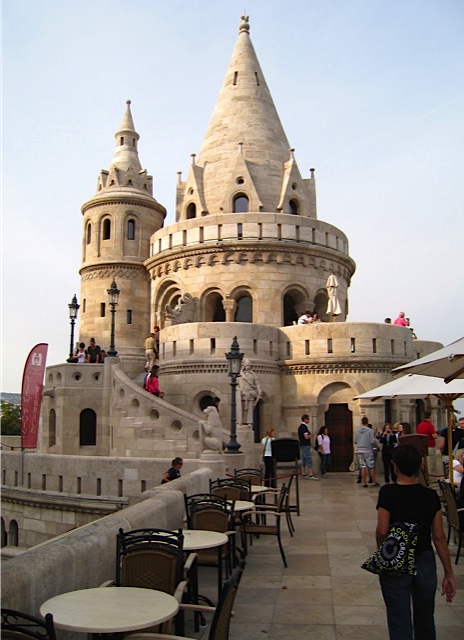 A short walk from the Royal Palace brought us to Fisherman’s Bastion. There are two explanations for the name: either a fish market was nearby in the Middle Ages, or the guild of fishermen defended this section of the wall. The landmark has breathtaking, panoramic views of the riverfront, and you can see to Margaret Island. I expected a bastion to look defensive, but this one didn’t. The ornate, neo-Romanesque towers, intended as observation posts, were built between 1895 and 1902 and erected to impress, not to protect. The bastion resembles a castle out of a fairy tale with its seven pointed turrets and flowing white walls—nothing you would expect from a fortification.
A short walk from the Royal Palace brought us to Fisherman’s Bastion. There are two explanations for the name: either a fish market was nearby in the Middle Ages, or the guild of fishermen defended this section of the wall. The landmark has breathtaking, panoramic views of the riverfront, and you can see to Margaret Island. I expected a bastion to look defensive, but this one didn’t. The ornate, neo-Romanesque towers, intended as observation posts, were built between 1895 and 1902 and erected to impress, not to protect. The bastion resembles a castle out of a fairy tale with its seven pointed turrets and flowing white walls—nothing you would expect from a fortification.
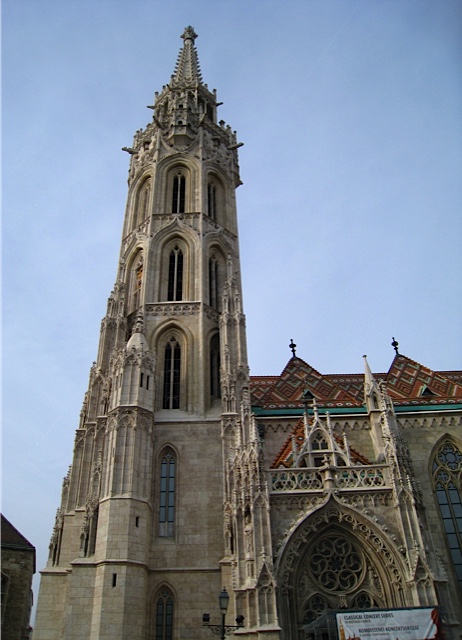 Next on our list was Matthias Church on Trinity Square. Originally built in 1255, the church underwent many changes, as well as renovations and additions. In 1541, when the Turks occupied the city, it was a mosque. When they were expelled in 1686, restoration began on the building, but it wasn’t until 1874 that the church was restored to its former glory. The roof has magnificent diamond-shaped multicolored tiles, and the tower roof is covered in colorful majolica tiles. Decorative gargoyles grace the exterior, and above the portal is a beautiful rose window, a circular window particularly characteristic of Gothic architecture. The interior is adorned with gold-leaf frescoes and stained-glass windows, the golden glow mystic. And because the acoustics are excellent, concerts are often held here.
Next on our list was Matthias Church on Trinity Square. Originally built in 1255, the church underwent many changes, as well as renovations and additions. In 1541, when the Turks occupied the city, it was a mosque. When they were expelled in 1686, restoration began on the building, but it wasn’t until 1874 that the church was restored to its former glory. The roof has magnificent diamond-shaped multicolored tiles, and the tower roof is covered in colorful majolica tiles. Decorative gargoyles grace the exterior, and above the portal is a beautiful rose window, a circular window particularly characteristic of Gothic architecture. The interior is adorned with gold-leaf frescoes and stained-glass windows, the golden glow mystic. And because the acoustics are excellent, concerts are often held here.
People still live on the castle hill, but cars are banned unless you live or work in the area or are a guest of the Hilton Hotel. However, the best way to explore these charming, crooked streets is on foot, as you can pause, take in your surroundings, snap pictures, and move on at your own pace. Later that day, we had reservations for a wine tasting at the Hilton, so we spent the next hour treating ourselves to a self-guided tour of the homes and other establishments on the hill, marveling at the different styles of architecture and giving our digital cameras a workout. We ended our photo shoot as we neared the hotel.
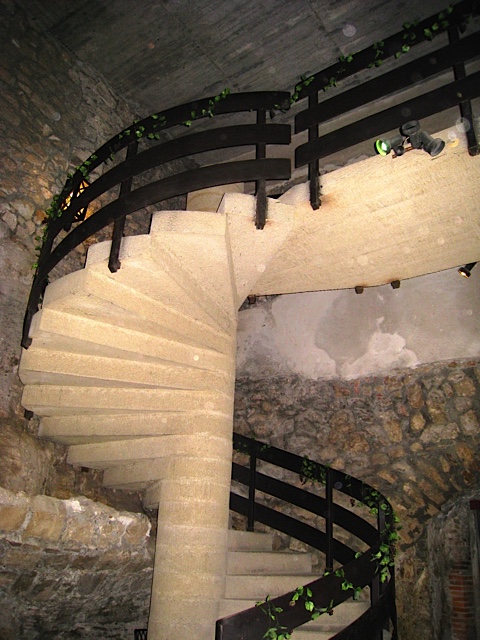 The Hilton, built in 1977, was constructed around the remains of a thirteenth-century Dominican cloister and monastery. Faust Wine Cellar is part of the vast underground labyrinth built by the castle inhabitants during the Middle Ages. During World War II, over twenty thousand soldiers could fit within it, which gives you a general idea of the cave’s enormous size.
The Hilton, built in 1977, was constructed around the remains of a thirteenth-century Dominican cloister and monastery. Faust Wine Cellar is part of the vast underground labyrinth built by the castle inhabitants during the Middle Ages. During World War II, over twenty thousand soldiers could fit within it, which gives you a general idea of the cave’s enormous size.
Inside the hotel, we descended the fifty-four steps to the cellar and immediately reached into our daypacks for a sweater and jacket. Our host offered us blankets, but we soon adjusted to the chilly temperature, and our attention turned to the variety of local wines our sommelier had chosen for the evening’s tasting. It is advisable to make reservations in advance, as the cellar is small and seating limited.
At the end of the two-hour wine tasting, we rode the funicular down the hill, crossed the Chain Bridge, and ate at a restaurant along the Danube River. We had another busy day planned, so after dinner we went straight to our hotel to relax.


Absolutely spectacular photos! Who wouldn’t want to go after reading this?!